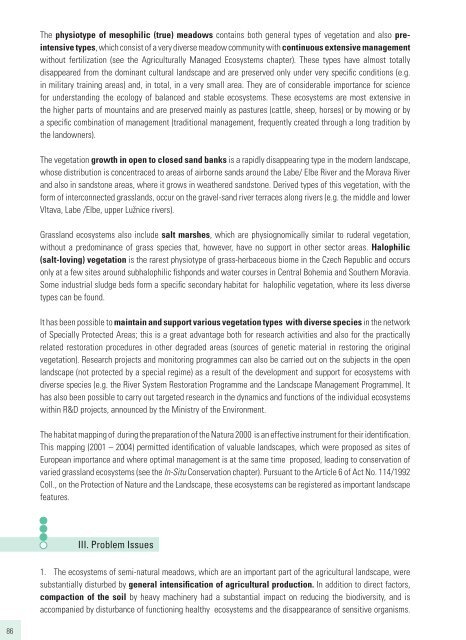B - Convention on Biological Diversity
B - Convention on Biological Diversity
B - Convention on Biological Diversity
- No tags were found...
Create successful ePaper yourself
Turn your PDF publications into a flip-book with our unique Google optimized e-Paper software.
The physiotype of mesophilic (true) meadows c<strong>on</strong>tains both general types of vegetati<strong>on</strong> and also preintensivetypes, which c<strong>on</strong>sist of a very diverse meadow community with c<strong>on</strong>tinuous extensive managementwithout fertilizati<strong>on</strong> (see the Agriculturally Managed Ecosystems chapter). These types have almost totallydisappeared from the dominant cultural landscape and are preserved <strong>on</strong>ly under very specific c<strong>on</strong>diti<strong>on</strong>s (e.g.in military training areas) and, in total, in a very small area. They are of c<strong>on</strong>siderable importance for sciencefor understanding the ecology of balanced and stable ecosystems. These ecosystems are most extensive inthe higher parts of mountains and are preserved mainly as pastures (cattle, sheep, horses) or by mowing or bya specific combinati<strong>on</strong> of management (traditi<strong>on</strong>al management, frequently created through a l<strong>on</strong>g traditi<strong>on</strong> bythe landowners).The vegetati<strong>on</strong> growth in open to closed sand banks is a rapidly disappearing type in the modern landscape,whose distributi<strong>on</strong> is c<strong>on</strong>centraced to areas of airborne sands around the Labe/ Elbe River and the Morava Riverand also in sandst<strong>on</strong>e areas, where it grows in weathered sandst<strong>on</strong>e. Derived types of this vegetati<strong>on</strong>, with theform of interc<strong>on</strong>nected grasslands, occur <strong>on</strong> the gravel-sand river terraces al<strong>on</strong>g rivers (e.g. the middle and lowerVltava, Labe /Elbe, upper Lužnice rivers).Grassland ecosystems also include salt marshes, which are physiognomically similar to ruderal vegetati<strong>on</strong>,without a predominance of grass species that, however, have no support in other sector areas. Halophilic(salt-loving) vegetati<strong>on</strong> is the rarest physiotype of grass-herbaceous biome in the Czech Republic and occurs<strong>on</strong>ly at a few sites around subhalophilic fishp<strong>on</strong>ds and water courses in Central Bohemia and Southern Moravia.Some industrial sludge beds form a specific sec<strong>on</strong>dary habitat for halophilic vegetati<strong>on</strong>, where its less diversetypes can be found.It has been possible to maintain and support various vegetati<strong>on</strong> types with diverse species in the networkof Specially Protected Areas; this is a great advantage both for research activities and also for the practicallyrelated restorati<strong>on</strong> procedures in other degraded areas (sources of genetic material in restoring the originalvegetati<strong>on</strong>). Research projects and m<strong>on</strong>itoring programmes can also be carried out <strong>on</strong> the subjects in the openlandscape (not protected by a special regime) as a result of the development and support for ecosystems withdiverse species (e.g. the River System Restorati<strong>on</strong> Programme and the Landscape Management Programme). Ithas also been possible to carry out targeted research in the dynamics and functi<strong>on</strong>s of the individual ecosystemswithin R&D projects, announced by the Ministry of the Envir<strong>on</strong>ment.The habitat mapping of during the preparati<strong>on</strong> of the Natura 2000 is an effective instrument for their identificati<strong>on</strong>.This mapping (2001 – 2004) permitted identificati<strong>on</strong> of valuable landscapes, which were proposed as sites ofEuropean importance and where optimal management is at the same time proposed, leading to c<strong>on</strong>servati<strong>on</strong> ofvaried grassland ecosystems (see the In-Situ C<strong>on</strong>servati<strong>on</strong> chapter). Pursuant to the Article 6 of Act No. 114/1992Coll., <strong>on</strong> the Protecti<strong>on</strong> of Nature and the Landscape, these ecosystems can be registered as important landscapefeatures.III. Problem Issues1. The ecosystems of semi-natural meadows, which are an important part of the agricultural landscape, weresubstantially disturbed by general intensificati<strong>on</strong> of agricultural producti<strong>on</strong>. In additi<strong>on</strong> to direct factors,compacti<strong>on</strong> of the soil by heavy machinery had a substantial impact <strong>on</strong> reducing the biodiversity, and isaccompanied by disturbance of functi<strong>on</strong>ing healthy ecosystems and the disappearance of sensitive organisms.86
















